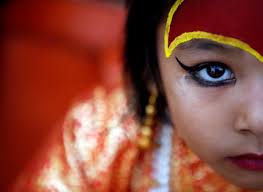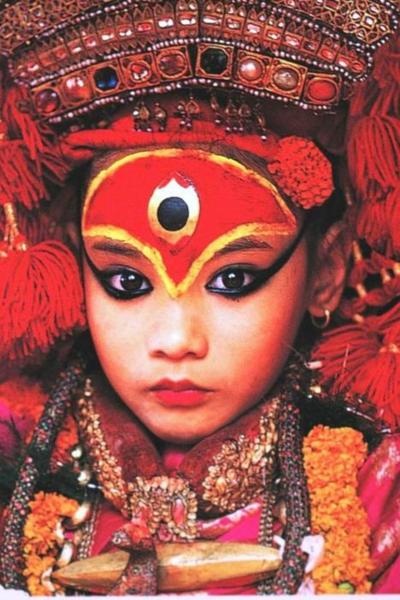
The Coming of Kumari
Since the coming of Goddess Taleju, the kingdom even divided had prospered and was in its peak times of architecture and agriculture. Many historic temples and courtyards were built. Many are gone as time passes by others need urgent renovation. The Kumari, Living Goddess, and myths and legends surrounding the Kumari, the Living Goddess of Kathmandu, are fascinating. Historical records show that the worship of Kumari as a living goddess has been prevalent since at least the 10th century,
But Popular folklore relating to the Kumari as the incarnation of Taleju Bhavani, the patron deity of the Royals, and the king conversing and playing dice with her are linked to certain kings who ruled Kathmandu, like Trailokya Malla (16th century) and the last Malla ruler of Kathmandu Jaya Prakash Malla (18th century). According to the legend, it so happened that one night while playing dice with Goddess Taleju, or Kumari, The king was aroused by her celestial beauty and was overcome with lust. The Kumari, a goddess as she was, at once visualized the affectionate thoughts in the king’s mind. Showing her utter displeasure, she declared that she would henceforth never come to him and disappeared. The King was filled with thoughtful regret and begged for forgiveness. The Goddess later relented and said that she would enter the body of a virgin girl, a Kumari, which the king was to worship.

Another version of the legend has it that the king and kumara used to play dice every night on the condition that no mortal would see them doing so. Accordingly, the king had strictly instructed the queen and his slaughter not to enter or peek into a certain room while he was inside. But curiosity got the better of the women, and they peeped inside. The angry Goddess then disappeared. The king repented and prayed for the Goddess, forgiveness Goddess Kumari then came in his dream and told the king that she would henceforth not come in person. Instead, the king was to worship a Shakya virgin girl who would keep her divine power. Since then, a Shakya virgin girl is worshipped as the Kumari, and once a year during the month of September, the living Goddess is taken around the old quarters of Kathmandu in her chariot during the Indra Jatra festival.

How is Kumari Goddess selected?
Kumari selection criteria are strict and include a number of specific physical perfections. Which is not as simple as one might think generally, kumari is selected under the supervision of five senior Buddhist priests, the chief royal priest of Taleju, and the royal astrologer of the Kumari goddess.
There are many kumaris in Nepal, the most renowned are from Kathmandu called the Royal kumari, and the other two are from Patan and Bhaktapur. Some Kumaris is selected shortly after their birth, and some go through the traditional selection process, although the selection process might be different according to the historical and traditional beliefs they have one thing in common they all must be from the Newari Buddhist family.
Kumari goddess must be the offspring of the Sakhya caste of silver and goldsmith, whose three-generation had not married other than the Sakhya caste. She must have an excellent health condition and have no history of serious illness, never shed blood from her body. To be appointed as a Kumari goddess, One must go through several traditional tests. Kumari must have 32 attributes and her horoscope is examined to see whether it is complementary to the king’s horoscope. One must have 12 sets of teeth, without any blemish, and dainty soft hands and feet. Some are poetically described such as:
- Eyelashes like a cow
- Thighs like of deers
- Neck like a cohen shell
- Chest like of lion
- Body like a Banyan tree
- A voice like a duck’s melodious
- Same horoscope as the kings
- The vision of calmness and fearlessness
- Black and straight hair and many more

After examining all the 32 attributions/perfections of the girl (according to Tantric ritual), she is then taken to a room. The wife of the head priest checks the little girl’s body to ensure that she has no blemishes on her body. The girl with no physical blemish and the strongest birth star is then selected. The selection process is done on the 8th day of Dashain also known as Kalratri.
The young girl then is taken to a room where 108 buffaloes and goats are sacrificed and offered to goddess Kali, which is exhibited in the dimly lit room with several masked men (Lakhya) dancing around. The girl is expected to show no fear and remain calm and fearless as she moves to the final trial. At the end of the selection process, several traditional ornaments are placed in front of the girl where she must select the same ornaments as the ex-kumari chose, only then she is appointed as a living goddess Kumari. Kumari is believed to be omniscient.
After the selection of the Kumari, she is taken to the dark room and then rituals are performed by the royal priest. Once the rituals (Tantric Purification) are completed, it is considered that the body is pure and the spirit of Taleju takes over the girl’s body.

The Kumari is then taken to the Kumari house (Kumari Chehh), where she will live until she is dethroned. Historically, The kumari houses were built next to the palace so that it would be easy for the royal family to visit the kumari without any difficulty and it’s been the traditional house of kumari, ever since. The courtyard of the kumari house is known as the Kumari Chowk.
Most toddlers are chosen as the Kumari because as soon as the girl gets her first menstrual cycle she can not be the manifestation of the Goddess Taleju, the youngest kumari ever selected as the incarnation of the Taleju Goddess was 3 years old. The oldest kumari is Dhana Kumari Bajracharya of age 73, Who is called the lifelong Kumari.

The ceremonial garment of the living goddess Kumari
Kumari is considered the symbol of beauty in the Newar community, and girls are often compared to the beauty of the kumari. The kumari never fails to fascinate the people with its beauty and divine power. You can identify Kumari from a distance due to her distinctive bright red Jama (cloak) down to her feet, red blouse called Bhoto, and an iconic opulent headpiece made out of gold and different types of precious metals and gemstones.

The chances of seeing kumari in any other colored clothes are very slim. She is not allowed to wear any other colored clothes rather than red, even if she stays at the house doing nothing. The clothes that the Kumari wear during the ceremonies and festivals are passed down from ex-kumaris.
Not only does the kumari have an iconic dress but her traditional ornaments are too bewitching. Most of the ornaments that you see were made in the 13th century, near the end of the Malla kingdom. This custom jewelry has deep meanings to it, kumari is seen wearing numerous types of ornaments from which two are easily recognized. The kumari wears loops of diamond and gold coins, and two necklaces that have deep spiritual meaning to them.
One is a golden chain made in the shape of a snake (Serpent) skillfully handcrafted with a snake scales pattern engraved with precious stones, also called “Bashuki naga”(God of wealth), which is the symbol of protection from evil. Another one is called Ta-yo, which has a cylindrical body with a complex shape. Ta-yo has multiple edges and consists of eight-headed miniature serpents above the conical cylinder. Ta-yo is the symbol of the eight mother goddesses, which represent prosperity and protection.
Her forehead is painted with (Tika) a crimson-red powder called sindoor (vermilion) covering her entire forehead with yellow pigment, which is a mixture of turmeric and sweet-smelling sandalwood. In the middle of her forehead is the fire eye (Agni-Chakshu). The fire eye represents the cosmic energy of the earth or the destroyer of all the evil in the world. The fire eye (Tri-Netra) is made up of novel (gold or silver) metals.
The Goddess Kumari is always seen in the topknot hairstyle decorated with fragrant flowers with red ribbon. The kumari is always seen in dramatic and attention-grabbing eye makeup that makes her look very different from the rest of the people, which has become her identification lately. Just like her forehead is painted with vermilion her feet are also painted with red pigments (Ala), traditional pedicures used by the Newars. Kumari doesn’t wear shoes but you may find her feet covered in red stockings.

Why can’t the feet of the Living Goddess Kumari touch the ground?

The feet of Kumari should not touch the ground in her appointed time as the Kumari because the ground is considered unholy and unworthy. As soon as the kumari steps on the ground the spirit of the Goddess Taleju leaves the body of the young Kumari. Her feet, like all of her, are known to be sacred. There are many Kumaris in Nepal most known Kumari are from Kathmandu (royal Kumari),
The peculiar life of Juvenile Kumari.

Once the Kumari goddess is chosen she will go through Tantric purification and advance towards her throne as the newly selected Kumari. Her life is vastly different from a normal child of her age, on most occasions she will be isolated from the world. Her playmates are very few including the offspring of her caretaker (Chitaidar), her limited friends must learn to respect her, although they have no age difference. Her every wish must be granted, which indicates they must learn to offer whatever they have. She is not allowed to share food with anyone and no one is allowed to walk before her as she is the most revered one.
The lifestyle of the kumari fascinates most people and even puzzles some. As soon as the juvenile girl is appointed as the kumari, she is taken to the Kumari Chehh (Kumari house) where she will live until she gets her first menstruation cycle. The kumari isn’t allowed to get out of the kumari house unless there is a ceremony that she needs to attend. The kumari only gets out of the kumari house 13 to 15 times a year at festivals such as Kumari Jatra.
The biological parents of Kumari are not allowed to live with Kumari in the kumari house, therefore a caretaker is provided to the kumari. The whole family of the caretaker lives at the kumari house with the kumari. As soon as the caretaker is unable to perform her job properly her eldest daughter takes over her position and hence, becomes the new caretaker of the kumari.
She is worshiped daily by the caregiver and by the royal priest on special occasions. Many devotees visit her on a daily basis to get the blessing and present her offerings such as food, toys, and new outfits. However, some devotees even offer golden jewelry as gratitude. Devotees bow down in front of the little girl and kiss her feet, then she offers them Tika and flowers as a blessing. She stays still on her throne while the devotees pay her homage, she shows little to no facial expression as it is considered an omen. The interpretation of her expression is as listed below:
- Crying or guffawing (Chronic illness or even Death)
- Weeping (moribund)
- Trembling (Captivity)
- Hand clapping (Reason to fear the king)
- Being picky with food offerings (Capital losses)
- If she remains silent and shows no facial expression, her devotees return delighted. This is a sign that their wishes have been granted.
Some people take care of the kumari’s every need, they are the caretaker of the kumari. As easy as it may seem, the reality is quite different. They are responsible for bathing her, feeding her, and preparing her every day for puja as well as getting her ready for the devotees and ceremonial rites. They are not allowed to give direct orders to do anything, they must guide and suggest. A personal tutor is provided to kumari where she learns academic knowledge without having to walk or travel anywhere.

The incarnation of Goddess Taleju. A living goddess lies nowhere in the world except in Nepal.
Stay curious and save our heritage and culture.





